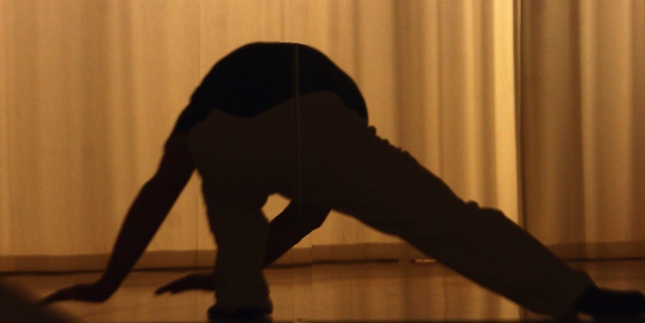The wisdom of ignorance
Knowledge creates insight, whether it's internal or external. However, inevitably at the same time it turns us away from ourselves.
Recognising oneself however means letting go of oneself. The fewer points of cristallisation one contains, the more freely the inner being can reveal itself and engender new life.
Knowedge and technique are by defintion particular points of cristallisation of our mind, Unprotected by them one is completely exposed and forced to be with oneself.
Taking the risk of being nakedly exposed to oneself and the outer world. is at the centre of our practice. This is why our training looks quite different from that of other Karate schools or Qi Gong institutes. We spend a lot of time on relaxing and dissovling the body. That can be very tiring. When the interior's structure is dissolved it can move freely within a technique and express itself within it. It shapes the technique from within.
A fist strike moves physical mass into the face of the opponent. It can also, if everything in us can join in with no encumbrance, reveal the true substance of our being. To those who can deliver themselves to their technique with no friction or reticence, it opens up a new vision of themselves.
The path towards creating truth through wholesomeness is long and does not always look pretty. In the end though, it leads to by far more effective techniques. Techniques become by far more powerful when the whole being is set free to collaborate on them, rather than being forced to do so by controlling willpower alone. This holds true for outward aiming Karate technique as for energetic and meditative techqniues that are directed inwards.
Knowledge and Non-knowledge
When we manage to let go, techniques tend to have a physically recognisable form. They may come to be by giving up control, but their appearance is not arbitrary. Stiffness and Tension stand in the way of letting go. A united bodily sphere in turn encourages it. Awareness of ourselves lets all parts of the body contribute to our movement and not be squeezed out from it. There is, hence, a "right" way of doing things. We just get there taking a long and somewhat winding road, rather than insisting on correct outer shape.
The long detour on our path to "proper" techniques makes our training not always look brilliant or even at times particularly effective. That is a risk we have to take. Our training gets its authentic strength from exactly the risk we incur finding ourselves first.
Teaching Ignorance
Teaching Ignorance is not easy. On the one hand, our teachers have to build a framework for our training, point the direction in which to moes and criticize techiques. The only fulfill their role though when they expose themselves to the risk of being reduced to their own being. The courage and willingness to let go and divest themselves of their protective knowledge, are the most important things they have to communicate. The risk of something going wrong or notn loking good is something we have to incur on a daily basis.
We are all learning and researching together. That's what gives our practice such a unique flair and deep-reaching power.
Fitting into the environment.
The annual practice calendar is a mirror image of that natural ebb and flow of practice intensity. There are points of high intensity during the long seminars. There, we find opportunity to really work in depth with no distraction or interruption. They define the parameters of practice for the whole term.
One day workshops offer refreshers and in regular weekly classes, we practice maintaining our stillness in the face of everyday hectic life.
Practice also adapts to the seasons. In winter, the environment pulls back and leaves us practically alone. That is the ideal time for a clear view inwards quiet exploration of one self. During spring and summer, the world around us flows much more freely and truthful being is by far more determined by finding one's proper place betwenn the environment and one's own active spirit and body.
Adapting to the changed surroundings expresses itself in different training styles - at times more static and slow at others more flowing and energetic.
Our Approach
Emptiness and Letting Go
Work in Depth
The basic thrust of our training has been the same right from the start. We use Karate-do and Stillness to physically unwind our being from our body's embrace, so as to let it be free and act freely.
This approach is very demanding on all levels, physically and mentally, regardless whether we pursue a more dynamic approach in Karate or focus on Stillness Practice.
Our Training aims to move fundamental structures. It is most effecitve in precisely those spheres where we can't consciously reach. It is designed to let changes occur there spontaneously.
In Karate, our apporach takes a huge detour on theroad to combat success. In its mental and emotional applications it points towards wholesome solutions, not partial ones. We don't do short term behavioural therapy.
The Irregular Flow
Quite naturally, the intensity of practice varies over time. It is best seen as a stream that swells at times, gaining speed, and quiets down at others. Someties we swim in the middle of the stream sometimes we drift aside. Most of us go through phases, turning inwards at times and outwards at others, applying their abilities in practical life.
This ebb and flow is quite natural. The decision when to practive more and when less is part of the growth process that our practice instigates.

In Depth:
Hintergrund und Theorie - Links zu theoretischen Texten von Malte Loos
Available only in German
Inside or out? A discussion on Marxism and inner self - with Mark and Malte ( in German again...)